|
The national average price of beef thigh and fillet in week 37 increased compared to the previous week. Beef thigh was priced at 280,000 VND, up 7.7% and the highest price so far this year. Beef fillet was priced at an average of 250,000 VND, up 0.8% compared to the previous week. The national average price of live cattle in week 37 increased slightly compared to week 36 from 82,000 VND to 83,000 VND, an increase of 1.2%. In the 38th week, beef fillet and beef thigh prices at Go supermarket decreased compared to the previous week, while prices of beef shank at Go supermarket and beef fillet at Winmart increased. Prices for other meats remained unchanged. Australian beef prices in Week 38 at supermarkets remained stable or declined slightly, with the exception of beef shank and Hokube beef sirloin at Homefarm supermarket, which saw a price increase.
0 Comments
The average prices of beef fillet (VND 248,000) and beef thigh (VND 260,000) in week 36 (Sep 11-15) showed a slight increase compared to the previous week by 1% and 4%, respectively. The average price of live-weight cattle has continuously decreased for 4 consecutive weeks compared to week 32. The average price of live-weight cattle in week 36 was 82,000 VND/Kg, a decrease of 4% compared to week 35. Prices in supermarkets Compared to last week, retail prices for most Vietnamese beef cuts have stayed the same or decreased in all stores except a slight increase in the price of Beef shank at Go Mart from VND 383,000 in the previous week to VND 385,000 in Week 37. Retail prices in Week 37 for most Australian beef cuts have stayed the same at Home Farm and WinMart but fell for Beef brisket at GO Mart, and beef shank and sirloin at Home Farm compared to the previous week. Prices increased for beef shank and shoulder clod at Go Mart, and short plate Kiaore at WinMart. Supermarkets lowered prices on certain beef items to encourage holiday shopping on September 2 During the National Day holiday of September 2, supermarkets lowered prices on certain beef items. Specifically:
Source: https://kinhtedothi.vn/sieu-thi-dong-loat-giam-gia-thit-lon-thit-bo.html Australian frozen quarter beef exports show signs of growth In August, the bone-in frozen beef category saw Australian exports total 5234 tonnes, more than 5% of total exports for the month, and 35% higher than August two years ago. Dealing in frozen quarter beef may be an attractive option for some beef processors at present, as a means of optimising plant throughput during the current period of high cattle supply pressure and low labour access. Source: https://www.beefcentral.com/news/frozen-quarter-beef-exports-show-signs-of-growth-whats-behind-it/ Tay Ninh province: Farmers are grappling with challenges as cattle prices remain at a low level From the beginning of the year until now, the price of live buffalo and beef cattle in Tay Ninh province continues to decrease compared to the same period in 2022, an average decrease of 15% to 25%, the lowest price in recent years. Consequently, numerous households engaged in buffalo and cattle farming have opted to reduce their livestock numbers to mitigate potential losses. Mr. Duc from Chau Thanh district shared that beef cattle, which is raised for a year and typically sold at an average weight of 250 kg, fetch only around 10 million VND. When considering all the expenses incurred, including insemination, vaccinations for diseases, and feeding, the farmer's profit amounts to less than 3 million VND. Consequently, he would incur financial losses if he purchases cattle for fattening. Mr. Tuan from Trang commune recently sold three beef cattles, with a combined weight of approximately one ton. However, his earnings amounted to slightly less than 60 million VND, a significant decrease from the over 90 million VND he used to receive in previous years. Mr. Tuan emphasized that, in his nearly decade-long experience of cattle farming, he has never witnessed cattle prices plummeting to such an extent as they have now. Mr. Vinh, a resident of Long Phuoc commune, recollected the years when buffaloes and cows held significant value, generating an annual income of nearly 150 million VND for his family. Raising these animals was instrumental in lifting his family and other farming households out of poverty. However, since late 2022 to the present, the prices of buffaloes and beef cattles have witnessed a decline. Concurrently, sourcing fresh grass has become progressively challenging, and rolled straw costs have risen from 25,000 VND per roll to over 40,000 VND. These factors have rendered livestock farming unprofitable. As reported by several traders in Chau Thanh and Ben Cau districts, once the lumpy skin disease epidemic was successfully controlled, the situation regarding buffalo and cow farming in the province began to stabilize and show signs of recovery. Nevertheless, the selling prices continued to decline. At the start of 2022, live buffalo was fetching over 90,000 VND per kilogram, but by the end of the same year, it had dropped to 60,000 VND per kilogram. Similarly, the price of live beef cattle also decreased, falling from 90-93 thousand VND per kilogram to approximately 80 thousand VND per kilogram. There was even a period when the price of live beef cattle dipped below 70,000 VND per kilogram. Nonetheless, despite a significant 45%-50% drop in live cattle prices, leading to financial losses for farmers, the prices of buffalo and beef meat in the markets have remained unchanged. Presently, commercial beef is still priced at 180,000 - 250,000 VND per kilogram, equivalent to previous years. Traders at the Ward 3 market in Tay Ninh city explained that while the price of live buffalo and beef cattle has decreased, other expenses such as labor, slaughtering, and transportation have risen. These additional costs have contributed to the stability of commercial beef prices. Source: https://nhachannuoi.vn/tay-ninh-gia-trau-bo-xuong-thap-nguoi-chan-nuoi-gap-kho/
Vietnamese version The average market price of buffalo fillet in Vietnam has remained relatively stable throughout most of 2023. The average price in Week 35 (VND290,000/kg) has dropped by 0.9 % compared to the previous week. Average beef fillet prices have witnessed a steady decline since the Lunar New Year in February, but the average price in Week 35 (VND235,000/kg) is a slight increase of 0.6 % compared to Week 34. The average national weekly prices of live-weight cattle have been more unstable in recent weeks compared to the initial weeks of the year. Compared to Week 34, the average price in Week 35 (VND83,000/kg) has slightly decreased by 1.2 %. In supermarkets, the beef prices for the week, remained the same or increased compared to the previous week, for all types of beef cuts except at Coop Mart which reported a decrease in prices of Beef Fillet and Brisket Navel End. Retail prices of Australian beef cuts in selected supermarkets have generally either remained the same or increased compared to the previous week.
|

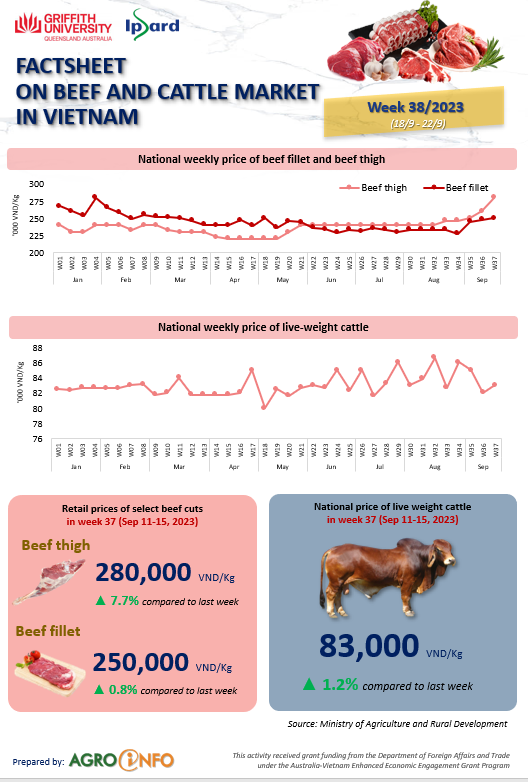

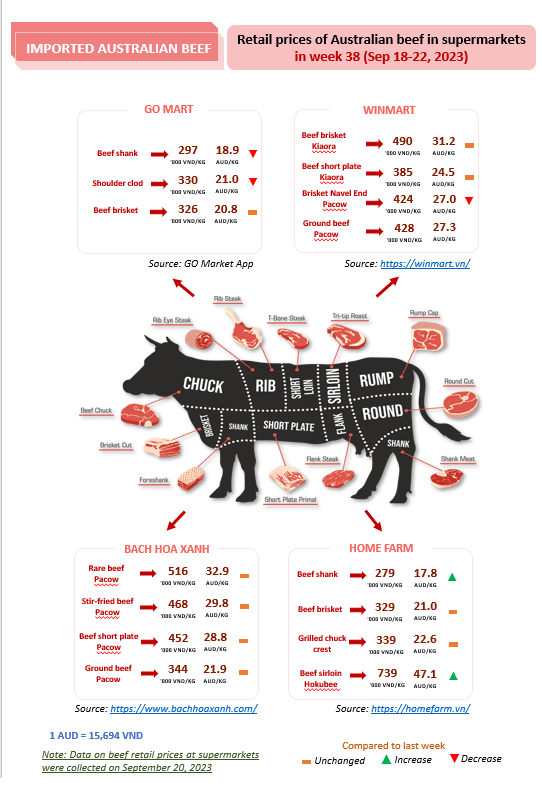
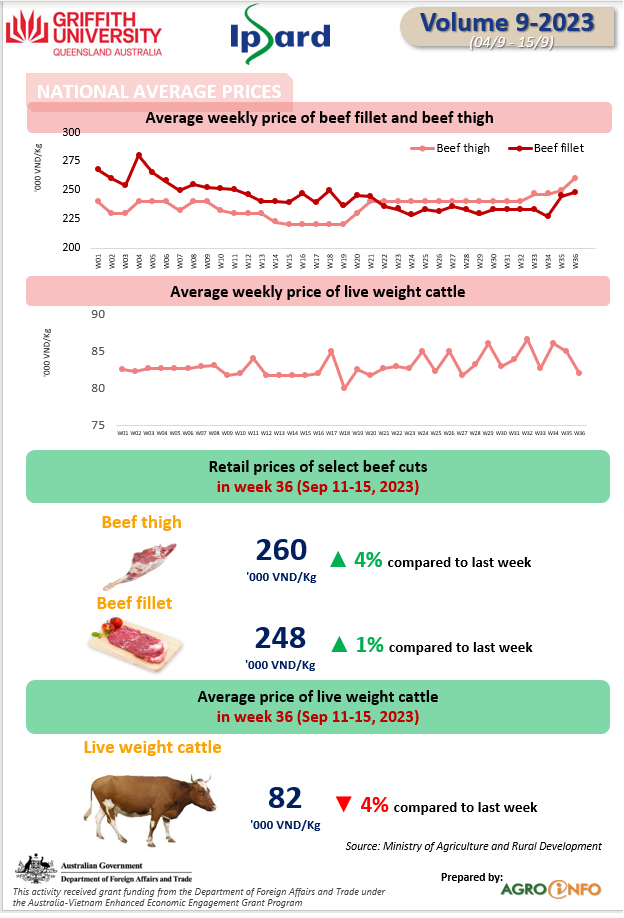


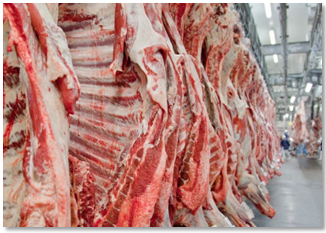

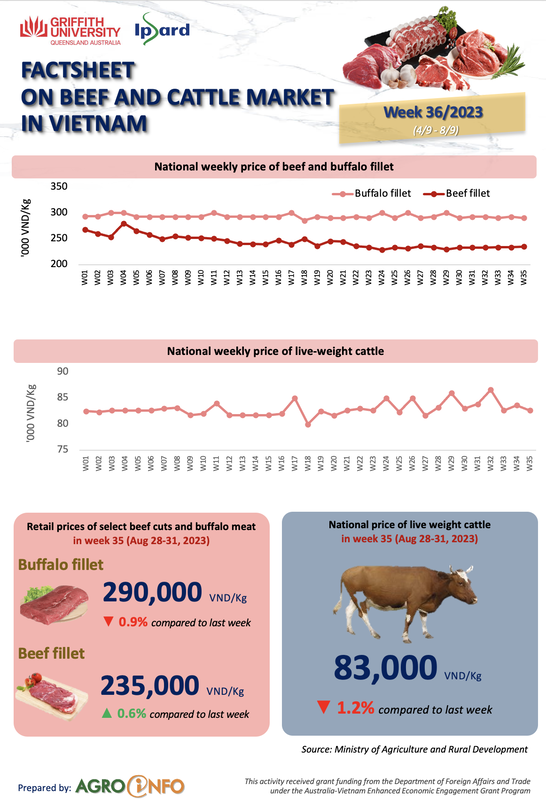
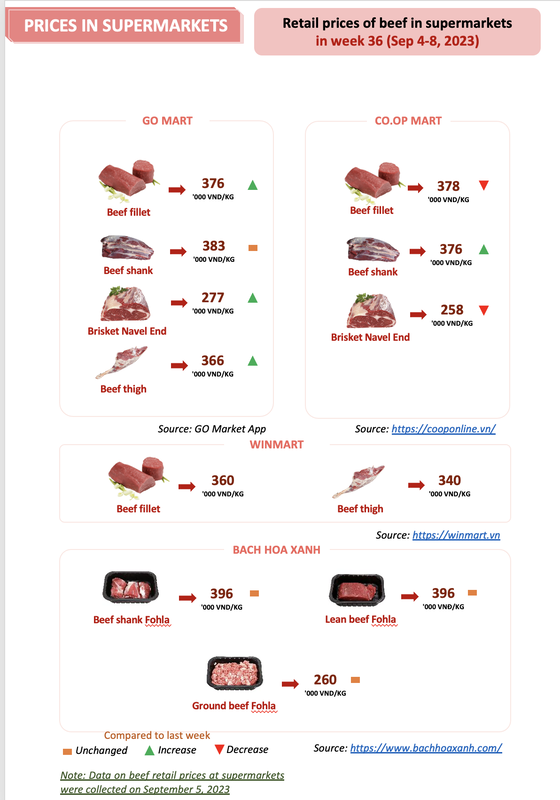
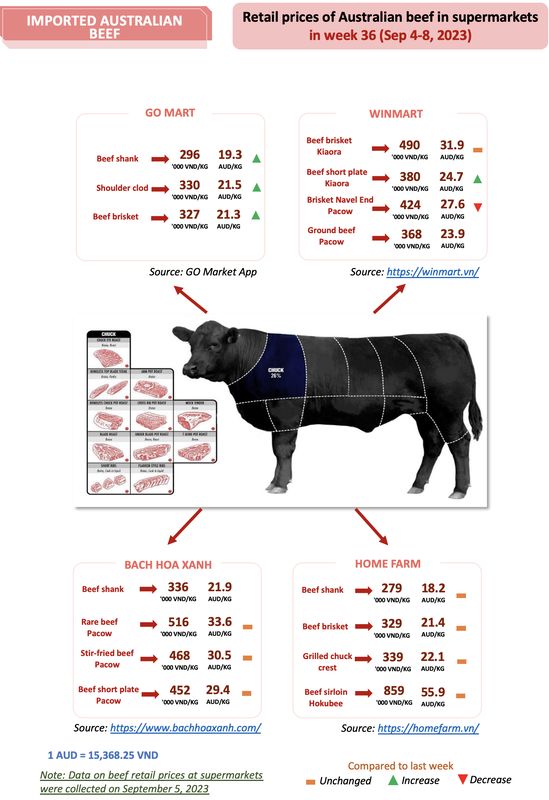
 RSS Feed
RSS Feed





